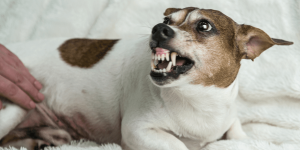Dog Bite Prevention.
In 2020, West Midlands Police dealt with 800 dog attack incidents and, tragically, many of these involved children. What is the best course of action if you, or someone you know, is bitten by a dog and what can be done to minimise the risk? Holidays4Dogs finds out more about dog bite prevention.
Dog bites commonly occur between owner and pet. Familiar household pets are most likely to inflict a bite on their owner. Unfortunately, this often involves children.
Why dogs bite.
Any dog is capable of biting. However, most will usually only bite if they are frightened, threatened, or provoked. Therefore, dog bite prevention relies heavily on making sure our dogs are not fearful.
However, most will usually only bite if they are frightened, threatened, or provoked. Therefore, dog bite prevention relies heavily on making sure our dogs are not fearful.
Many dogs bite accidentally during play, or while snatching treats. Puppies commonly bite, or nip, when they are teething, or exploring their environment.
Dogs can also bite if they are sick or in pain. Always be wary of touching a dog that might be in pain.
In rare cases, dogs will attack if they have been trained to do so. However, owning a ‘guard’ dog is not an excuse for allowing a dog to bite a person.
Indeed, the Guard Dogs Act 1975 states that a capable handler must be in charge of a guard dog at all times. The dog must be under control and not allowed to roam premises at liberty.
The importance of training.
Dogs should have adequate training and socialisation from a young age. This will go a long way to addressing dog bite prevention.
Equally, children should know how to interact safely with dogs, (family dogs and strange dogs). Supervision of babies and toddlers is advised when in the presence of dogs.
Avoid petting unfamiliar dogs, especially if they are tethered, or behind a gate, or fence.
Dogs rarely attack without reason. A dog’s natural behaviour is to avoid conflict. However, they may react to threats, or they may be fearful.
Signs to watch out for that a dog may bite;
-
Licking of lips. Ears Flattened. Low posture.
-
A slow wagging tail. A wagging tail does not always mean a dog is friendly.
-
Growling, curling of lips, bearing of teeth.
These are the many signs most dogs will give, before they resort to actual biting. This is an important point in dog bite bite prevention. Always back off from a dog who behaves in this way and give them space.
What to do if a dog bites you.
If you suffer a dog bite, immediately clean the wound however superficial it seems. This will reduce the chance of infection. If the wound is bleeding heavily, apply pressure with a clean pad and seek medical attention straight away.
In some situations it may be necessary to go directly to the nearest accident and emergency department of your local hospital. Doctors will examine the wound thoroughly for deep tissue damage or broken bones. People with dog bites may also require a tetanus injection.
What the law says.
If you suffer a significant dog bite from someone else’s dog you should report it to the police, since this is a serious offence and needs addressing. Dog bites have increased significantly amongst delivery drivers. Experts think this is due to an increase in delivery driver roles, as well as a rise in the number of pet dogs.
Solicitors have seen a rise in people making claims against insured dog owners for dog bites. Owners can be prosecuted if their dog is dangerously out of control. It is important, in serious cases, to exchange details with the owner of the dog and notify the police where possible. Clearly, dog bite prevention in the first place is key.
Conclusion.
Dog bite prevention is an important issue for everyone. However, most dog bites rarely happen without reason. Be aware of signals which may indicate a dog may bite – be that your own dog, or one belonging to someone else.
Be aware of signals which may indicate a dog may bite – be that your own dog, or one belonging to someone else.
Take care to train your dog sufficiently and ensure he is under control at all times. Your dog should wear a muzzle if you think he may bite while out in public.
If your dog’s behaviour concerns you, arrange an appointment with your vet. Your dog can be evaluated for any underlying health conditions which may be making him behave aggressively.
If your dog has no physical condition which may account for his behaviour, your vet can refer you to a behaviourist.



